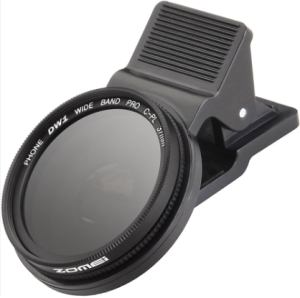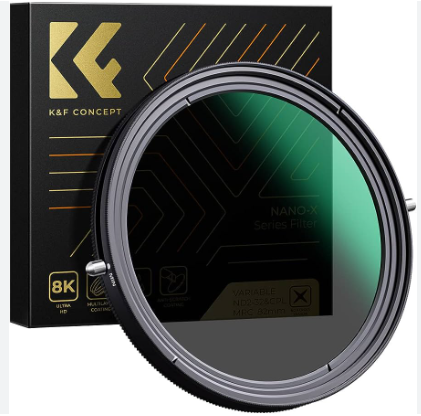Camera Polarizer Lens
In the realm of photography, capturing images that truly captivate the viewer requires not only skillful composition and timing but also the right equipment. One indispensable tool that often goes unnoticed yet yields remarkable results is the polarizer lens. Renowned among professional photographers and hobbyists alike, the best camera polarizer lenses possess the power to transform an ordinary scene into an extraordinary masterpiece. In this exploration, we delve into the world of polarizer lenses, uncovering their benefits, types, and how they elevate the quality of photographs.
Unveiling the Magic: Understanding Polarizer Lenses
A polarizer lens is a piece of optical glass that, when attached to a camera’s lens, can selectively block certain polarized light rays. Polarized light consists of waves that vibrate in a specific direction, and a polarizer lens acts like a gatekeeper, allowing only light waves vibrating in a particular orientation to pass through. This remarkable property enables polarizer lenses to mitigate reflections, enhance colors, and saturate the sky, resulting in vivid and striking photographs.
Enhancing Color and Saturation
One of the most remarkable aspects of polarizer lenses is their ability to enrich colors and increase saturation. When sunlight bounces off various surfaces, it often becomes polarized, leading to washed-out and less vibrant colors. A polarizer lens counteracts this phenomenon, absorbing a significant portion of the polarized light and allowing the camera to capture the true essence of colors. The result is a photograph that bursts with life, conveying the vibrancy of the scene as perceived by the naked eye.
Minimizing Glare and Reflections
Glare and unwanted reflections can significantly degrade the quality of a photograph. Whether it’s the glint of sunlight on water, reflections on glass windows, or the shiny surface of leaves, these distracting elements can obscure the subject and create an unappealing visual experience. A polarizer lens can effectively eliminate or reduce these reflections, revealing the subject’s true beauty and enhancing the overall composition. This is particularly advantageous when photographing landscapes, architecture, and still life scenes.
Empowering the Skies
Landscape photography often presents the challenge of capturing a captivating sky, especially when dealing with harsh sunlight. A polarizer lens comes to the rescue by darkening the sky, increasing the contrast between the blue heavens and fluffy white clouds. This effect, often referred to as the “polarizer blue,” lends a dramatic and dynamic quality to the photograph, drawing the viewer’s gaze and adding depth to the composition. The result is a visually compelling image that transports the viewer to the moment of capture.
Types of Polarizer Lenses
There are two main types of polarizer lenses: linear polarizers and circular polarizers. Linear polarizers were the first to be introduced, but their use in modern cameras can sometimes interfere with auto-focus and metering systems. Circular polarizers, on the other hand, have an additional layer that helps circumvent these issues, making them the more common and preferred choice for photographers today.
Choosing the Best Camera Polarizer Lens
Selecting the best camera polarizer lens can be a meticulous process, as various factors come into play. Compatibility with the camera’s lens diameter is paramount, ensuring a snug fit without any vignetting. Furthermore, the quality of the polarizing material is crucial, as a subpar lens can introduce unwanted optical distortions or color shifts. Investing in lenses from reputable manufacturers known for their optics expertise guarantees a superior experience.
Exploring Polarizer Lens Brands
Several renowned camera lens manufacturers have consistently delivered exceptional polarizer lenses, each with its unique features and advantages. Brands like Nikon, Canon, Sony, and Sigma offer a range of polarizer lenses tailored to different photography styles and preferences.

Nikon’s Precision: Nikon’s legacy in the world of photography is well-established, and their polarizer lenses continue this tradition of excellence. With multi-coated optics and durable build quality, Nikon’s lenses are designed to deliver impeccable results while withstanding the challenges of the field.
Canon’s Clarity: Canon’s polarizer lenses are renowned for their exceptional clarity and precision. Whether it’s capturing sweeping landscapes or detailed macro shots, Canon’s lenses ensure that every element of the composition shines through with unparalleled brilliance.
Sony’s Innovation: Sony has brought its innovation prowess to polarizer lenses, incorporating advanced technologies that cater to the needs of modern photographers. These lenses not only enhance image quality but also offer compatibility with Sony’s mirrorless camera systems, making them a favorite among enthusiasts and professionals alike.
Sigma’s Versatility: Sigma has carved a niche for itself by offering lenses that combine quality with affordability. Their polarizer lenses are no exception, providing a versatile range of options for photographers seeking exceptional performance without breaking the bank.
A Guide to Choosing the Best Camera Polarizer Lens
A polarizer lens is an essential tool for photographers seeking to enhance their images by reducing reflections and glare, improving color saturation, and increasing contrast. Choosing the right camera polarizer lens can significantly impact the quality of your photographs. In this guide, we’ll explore the key factors to consider when selecting the best camera polarizer lens to elevate your photography game.

Type of Polarizer: Linear vs. Circular
There are two main types of polarizer lenses: linear and circular. Circular polarizers (CPL) are designed for use with autofocus and digital SLR cameras, as they maintain the camera’s internal metering and autofocus systems. Linear polarizers, on the other hand, can cause issues with modern cameras’ metering and autofocus. Therefore, for most modern cameras, a circular polarizer is the preferred choice.
Size Compatibility: Filter Thread Diameter
Camera lenses come in various diameters, and it’s crucial to choose a polarizer lens that fits your specific lens. Look for the filter thread diameter indicated on your lens or lens cap (usually in millimeters), and select a polarizer with the corresponding diameter size.
Build Quality and Coatings: Optical Performance
Opt for a high-quality polarizer with multi-coated glass elements. Multi-coatings help minimize reflections, ghosting, and flare, ensuring optimal optical performance. A well-built polarizer also offers better durability and resistance to environmental conditions.
Effectiveness in Reducing Glare and Reflections
One of the primary purposes of a polarizer lens is to reduce glare and reflections. Test the polarizer’s effectiveness by attaching it to your camera and rotating it while observing the changes in glare and reflections. Choose a polarizer that provides a noticeable reduction in these unwanted elements.
Color Saturation and Contrast Enhancement
A good polarizer should enhance color saturation and contrast in your images. To evaluate this, take sample shots with and without the polarizer under different lighting conditions. Look for images with more vibrant colors and improved contrast when the polarizer is used.
Ease of Use: Rotating Ring and Operation
The polarizer’s rotating ring allows you to adjust the polarization effect. Ensure that the ring moves smoothly and is easy to operate, even when the lens hood is attached. This convenience becomes crucial when you need to make quick adjustments while shooting.
Price and Brand Reputation
While investing in a high-quality polarizer is recommended, consider your budget and explore reputable brands known for producing reliable camera accessories. Research customer reviews and seek recommendations from experienced photographers to find a polarizer that offers excellent value for money.
Compatibility with Lens Attachments
If you frequently use lens attachments like lens hoods or filter holders, ensure that the chosen polarizer is compatible with these accessories. Some polarizers might have a slim profile to prevent vignetting when using wide-angle lenses.
Conclusion
In the world of photography, where every detail matters, the best camera polarizer lenses stand as unassuming yet indispensable tools. With their ability to enhance colors, reduce reflections, and saturate the skies, these lenses elevate photographs to new heights, transforming scenes into captivating visual narratives. Whether it’s capturing the grandeur of nature, the intricate details of architecture, or the essence of a moment, a high-quality polarizer lens empowers photographers to craft images that resonate with viewers on a profound level. As technology continues to evolve, these lenses remain a steadfast ally in the pursuit of visual storytelling excellence.
FAQs about “Best Camera Polarizer Lens
What is a polarizer lens for a camera, and how does it work?
A polarizer lens is an optical filter used in photography to reduce glare and reflections from non-metallic surfaces, such as water or glass. It works by selectively blocking light waves that vibrate in certain directions, which helps enhance colors, improve contrast, and reduce unwanted reflections in your images.
Why should I consider using a polarizer lens for my camera?
A polarizer lens can significantly enhance the quality of your photographs by reducing glare, increasing color saturation, and improving overall image clarity. It’s especially useful when shooting outdoors, around water bodies, or in bright conditions where reflections and unwanted light can affect your shots.
What factors should I consider when choosing the best polarizer lens for my camera?
When selecting a polarizer lens, you should consider factors like the lens thread size (to ensure compatibility with your camera’s lens), the type of polarizer (circular or linear), the quality of glass and coatings (for optimal light transmission and image quality), and whether it suits your specific photography style and needs.
Can I use a polarizer lens with other filters or accessories?
Yes, you can often use a polarizer lens in combination with other filters or accessories, such as neutral density (ND) filters or UV filters. However, stacking too many filters may increase the risk of vignetting or image quality degradation, so it’s important to test and balance your setup accordingly.
What are some recommended brands or models for the best camera polarizer lens?
Several reputable brands offer high-quality polarizer lenses for cameras, including B+W, Hoya, Tiffen, and Singh-Ray. Specific models and recommendations may vary depending on your camera system, lens diameter, and personal preferences. Reading reviews, seeking professional advice, and comparing features can help you find the best polarizer lens for your photography needs.
